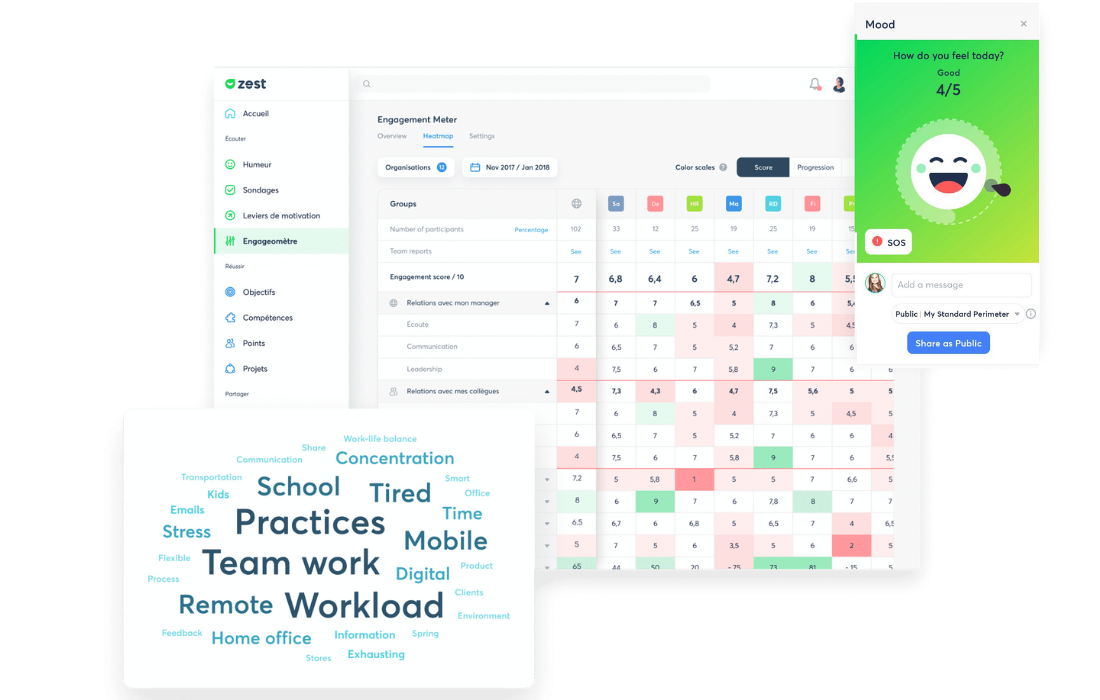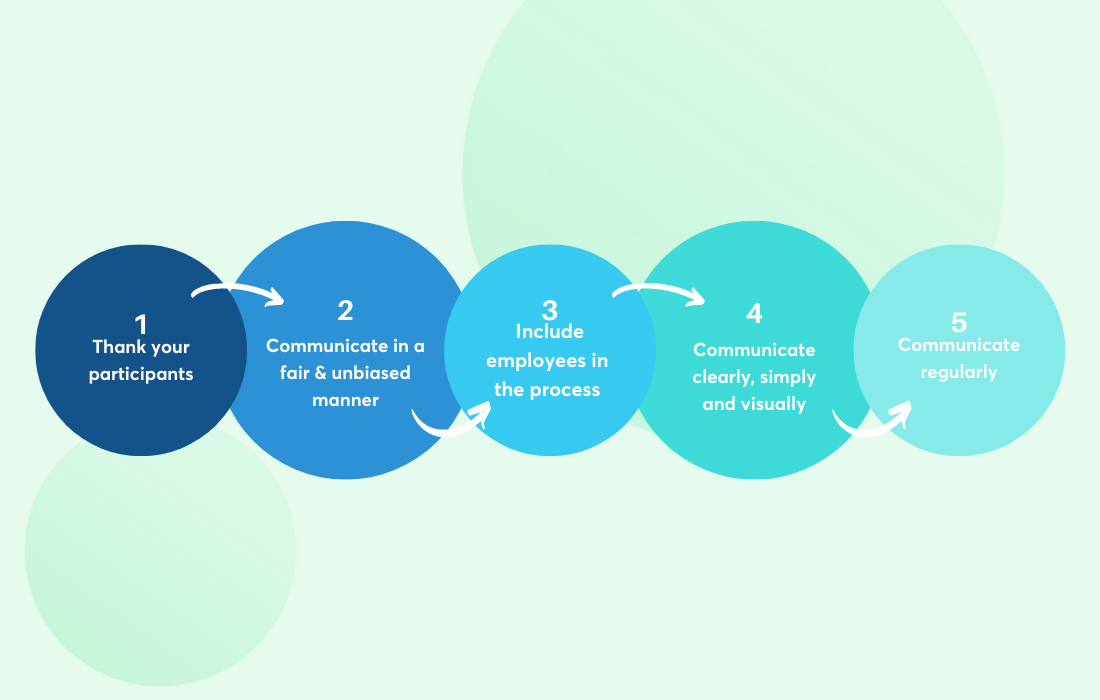« The way your employees feel is the way your customers will feel. And if your employees don’t feel valued, neither will your customers. »
Sybil F. Stershic, author & founder of Quality Service Marketing
Surveys are a useful tool to gauge employee opinions and levels of satisfaction regarding a variety of different topics. They’re also a convenient way for organisations to show how they value their employees. However, whilst carrying out a survey and ensuring employee participation is a critical first step, alone it is clearly insufficient, demonstrating that whilst the organisation may have heard employee opinions, their value is negligible.
So, what’s the key… Communication!
Communication post-survey is just as important as that pre-survey. Organisations invest a great deal of time & effort in communicating about the launch of a survey campaign to encourage participation. Consequently, the same level of investment should be made regarding the communication plan following a survey’s closure. This communication plan should be developed with the following objectives in mind:
- To allow each individual employee to connect their own personal experience with the overall results.
- To demonstrate the organisation’s commitment to creating positive change through dedicated action plans.
Here are Zest’s 5 top tips to consider when designing this post-survey communication plan.
No. 1 – Thank your participants
Thanking employees for their participation is the first step to ensuring that employees feel their opinion and input to the survey is of value to the organisation. It is also the perfect opportunity to mention if the response rate was particularly high and to capitalise on this success. Whilst being obvious, it’s a critical part of the communication plan and its importance should not be underestimated.
Firstly, recognition, or a lack of it, can influence employee intentions to remain within the organisation (source: Gallup). Afterall, acknowledgement is a key driver of employee performance, engagement and also participation in any future surveys. Secondly, sending this message of thanks, reminds employees of the company’s commitment to taking action in response to results and to creating positive change within the organisation, whatever the topic of the survey. Through Zest’s pillar “Listen”, managers can further demonstrate this commitment to action by creating collaborative action plans and objectives, with start and end dates, which can be made visible to all employees if so desired.
No. 2 – Communicate in a fair & unbiased manner
There are two key points to take away from this tip: fairness in what is communicated and fairness in how it is communicated.
Firstly, be honest about the results: it’s important to communicate both the good and the not so good. Give employees a fair impression about what the results really showed – hiding results could only make it more difficult for employees to relate their own personal experience to what the organisation is telling them came out of the survey. Highlight the positive findings and demonstrate the organisation’s commitment to continue these best practices. Equally, present the not so positive findings (“challenges”) and state the actions that will be taken to address them.
The second part of this tip refers to the way in which results are communicated. It is important for all employees to receive the same information regarding the survey at the same time. This helps to avoid the potential issue of information being lost down the pipeline, or the issue of the same information being presented and subsequently interpreted in different ways by different people (as can often be the case with a “cascading communication” method). An effective way to present information equally to employees is to carry out a live webinar involving the whole organisation with an opportunity for a Q&A session at the end. This session should be recorded to ensure that all employees can attend, whether that be live or in their own time afterwards. Communicate about this webinar using Zest’s module “Company Message” to ensure that the information gets to everyone!
No. – 3 Include employees in the process
Following on from this whole organisation webinar, organising focus groups is a great way to further explore the results and to enable individuals to really relate their own personal experience to the overall results. During these sessions, managers and employees are able to focus on more localised results together, to identify specific strengths and weaknesses, to define key localised challenges to address and to build a team-level action plan through a collaborative process. As previously mentioned, managers can use Zest’s digital platform to create action plans and share them with the team. Including employees in this process both helps to make them actors in the change process and also to demonstrate how the organisation truly values employee contributions.
No. 4 – Communicate clearly, simply and visually
Create visual representations of the survey results using graphs, charts & graphics. These will not only be more easily understood by employees (afterall, our brains are much better at processing visual stimuli than words) but also better remembered, which can subsequently serve to ensure that employees follow-up those key change actors within the organisation. Build a one-page “infographic” highlighting all the main or important survey results (ideal for short surveys) or create a single column summary infographic whereby readers can scroll through results as if they were a story (better for longer surveys). These infographics can be presented to employees during the overall results webinar and sent out to them afterwards through Zest’s internal communication stream “Company Messages” to keep a digital record. They can also be used as a way to present localised results during the focus groups between managers and employees.
No. 5 – Communicate regularly
At first, communication should focus on emphasising the survey results and the decisions taken to create positive change within the organisation. But it doesn’t have to stop there… Build a regular plan of communication through Zest’s module “Company Messages” (part of the pillar “Share”).
Consistently highlight the organisation’s commitment to boosting employee morale and satisfaction by communicating on the progress of these change initiatives. Don’t assume that employees are always aware of organisational efforts, it’s important to emphasise these through internal communication streams. Celebrate successes and acknowledge when organisational efforts don’t quite make the bar. Regularly remind employees of the promises made by the organisation and the objectives set. Individuals responsible for facilitating this change (often managers) will feel more inclined to take action if employees are regularly reminded of the organisation’s commitment. Encourage employees to use Zest’s feature “Share” to facilitate & digitalise feedback regarding these change initiatives.
Conclusion
Developing an effective post-survey communication plan is an integral part of a survey’s success. Through fair, unbiased, clear & regular communication, recognising employee contributions and including them at all stages of the process, organisations can truly demonstrate the value of employee opinions. Such an approach will not only help to boost employee engagement but also help to build a culture of trust whereby employees see the organisation’s commitment to fulfilling its promises.







